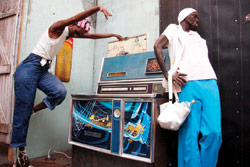Central to the African-American experience of the 1950s and '60s was the juke joint. An unlicensed liquor dispensary, it was a place for people to get together, relax, dance and drink. Free of the pressures of home or work, the juke joint was in many ways the only place where people could be themselves. Artist Willie Little developed the Juke Joint art installation to memorialize that experience. The multimedia work is currently on display at Asheville's YMI Cultural Center.

Little grew up in the tiny rural town of Little Washington, N.C. There his father ran a small grocery; after hours, Little's Grocery was transformed into a juke joint. Little's expansive exhibit is closely modeled on that store and its nighttime regulars.
All of the Juke Joint characters are based on real people. "I was the youngest in the family, but I felt like I was privy to grown folks' conversations," Little says. "I was like a sponge, absorbing everything that was around me. And I told myself one day, 'I'm going to remember this for the rest of my life.' Every Thanksgiving, my sisters and I would sit at the dinner table and start talking about these characters. We would always start with Eshu and Glory." Juke Joint depicts that couple "out back" engaging in stand-up conjugal activity.
"My two sisters — who are older than me — are great mimics; one of them is even a better mimic than me. So we would become the characters' voices, and we would have a great time. So I remember these very vivid stories, because we talked about them all the time. I carry them with me."
In Juke Joint, as in most of Little's work, the artist aims to convey and elicit a "visceral, emotional feel." To that end, he makes extensive use of found objects. "I really want people to have a total three-dimensional experience with the work. Found objects always speak to me. I wanted to capture all of the objects that really put you in the moment."
One character's "hair" is made of sweetgum balls. "I tried to use natural elements for all of the mannequins' hair," Little says. "I wanted to communicate that earthy, organic feel. All of the characters are very salt-of-the-earth."
While the store counter — complete with vintage items common to the era — is a centerpiece of the installation, other items are integral to the overall multimedia experience.
Willie Little's narration emanates from inside a gutted vintage Wurlitzer jukebox. Over the course of ten minutes, the artist often slips deftly into the characters on display. Classic R&B and soul hits drift in and out of the mix, adding to — but never overwhelming — Little's storytelling.
Since its creation in 1996, Juke Joint has traveled to more than a dozen venues, including the Smithsonian. Little marvels that this work has "developed a life of its own, and has in some ways come full circle." Initial funding came from an Emerging Artists Grant from the N.C. Arts & Science Council. The installation premiered at Charlotte's Afro-American Cultural Center; at that time, Little notes that it was "a series of three vignettes: Eshu and Glory, Miss Odell, and Miss Beaulah."

In fact, one of Juke Joint's first stops on its early travels was Asheville's YMI. In its current configuration — including a three-quarter scale architectural rendering of Little's Grocery — the exhibit now consumes two large adjoining rooms at the YMI.
One Asheville native who attended the opening reception enthusiastically shared many stories from his own youth on and around "the block". Those stories – lurid, moving and humorous — dovetailed neatly with the Juke Joint piece.
In Asheville, places like the one Juke Joint depicts were called "hooker houses." But in this case, "hooker" referred not to a sex worker, but a unit of measurement. "A hooker was a 25-cent glass of corn liquor," says the man, who didn't wish to be identified. "A 50-cent serving was called a bat-wing." The neighborhood through which South Charlotte Street now runs (destroyed in a fit of late-'60s "urban renewal") was once filled with hooker houses up and down both sides, he says. "If you started at one end of the street, you couldn't make it to the other end, you'd be so drunk," he says.
Whether from Atlanta, Baltimore, Asheville or elsewhere, visitors connect with Juke Joint's authentic evocation of a beloved part of the African American experience. "I created it as a personal journey and celebration," Little allows. "But as I met people who'd see it, I realized I was telling other peoples' stories as well. I believe that the more specific you are with a story, the more universal that story really is."
[Bill Kopp (Twitter @the_musoscribe) is an Asheville-based music journalist whose features and reviews can be found at blog.billkopp.com and www.musoscribe.com.]
who: Willie Little
what: Juke Joint art installation
where: YMI Cultural Center, 39 S. Market St.
when: Through March 28. Gallery hours Tuesday through Friday, 10 a.m. to 5 p.m. www.ymicc.org



Before you comment
The comments section is here to provide a platform for civil dialogue on the issues we face together as a local community. Xpress is committed to offering this platform for all voices, but when the tone of the discussion gets nasty or strays off topic, we believe many people choose not to participate. Xpress editors are determined to moderate comments to ensure a constructive interchange is maintained. All comments judged not to be in keeping with the spirit of civil discourse will be removed and repeat violators will be banned. See here for our terms of service. Thank you for being part of this effort to promote respectful discussion.